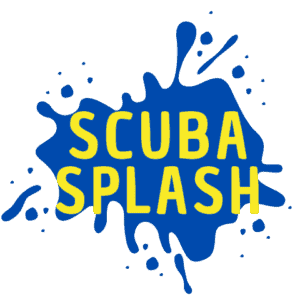Cage diving was first introduced in the 1950s and was originally used by filmmakers up until the late 1970s. It wasn’t until the early 2000s that cage diving became a popular tourist attraction.
Cage diving allows thrill-seekers the opportunity to get up close and personal with some of the most dangerous predators of the ocean. It’s an extremely unique opportunity to look directly into the eyes of highly dangerous sharks.
Cage diving was invented by French filmmaker Jacques Yves-Cousteau in the 1950s with shooting The Silent World. It was a documentary about the ocean and diving.
There are 440 species of sharks and the majority of them are docile. However, large and more aggressive species such as great white, bull, mako, oceanic whitetip, and tiger sharks are known to attack and sometimes without being provoked.
Shark Facts:
- Hammerheads have 360-degree vision
- Whale sharks can grow 40 feet (12 m) long
- Certain species of sharks can live in freshwater lakes and rivers
- Dogfish sharks are pregnant for 2 years
- Bull sharks have a more powerful bite than great whites
- 93% of shark attack victims are men
- Tiger sharks are known the eat anything including metal and cameras
- Shark skeletons are 100% cartilage
- Sharks can be dated back 450 million years ago
- Great white sharks can smell one drop of blood in an Olympic-sized pool
Top 10 Cage Diving Locations Around The World:
10.) Point Judith, Rhode Island, USA
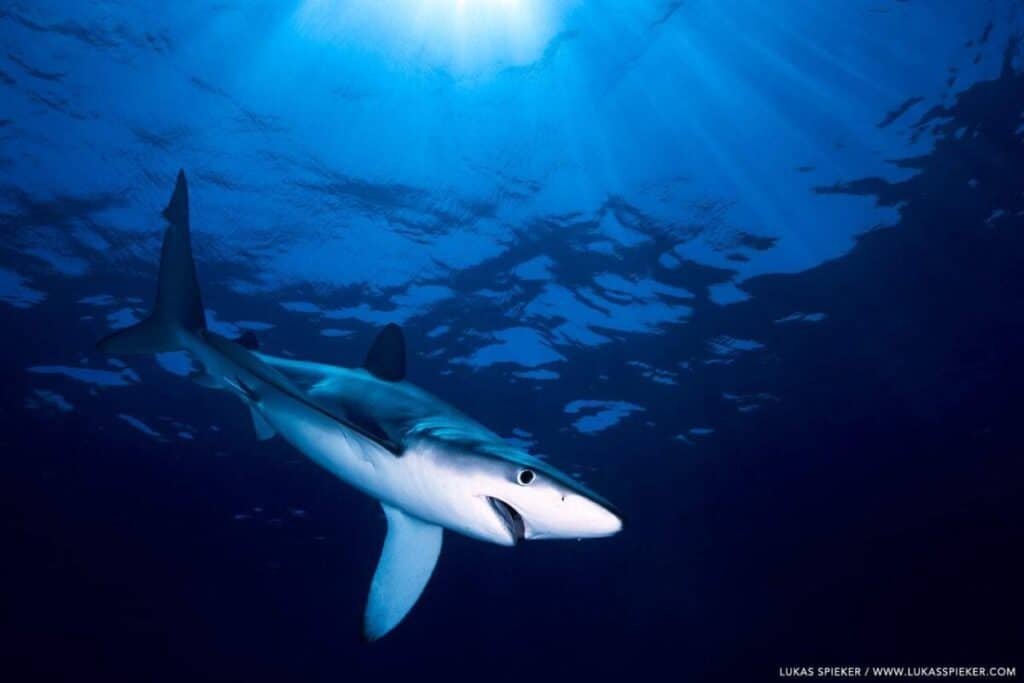
Expect to See: Mako, hammerhead, tiger, silky, blue, and basking sharks, dolphins, tuna, jellyfish, turtles, whales
Best Time to Go: June-September
Cage diving was first introduced to the east coast of the USA in 1976. It was off the coast of Point Judith, Rhode Island that it was first offered to divers.
To cage dive you need to be certified as a diver. There is also an option to stay above the surface and peer into the water using a mask for people who are not certified.
Chum is used to lure in the sharks. Expect to see different species of sharks that range in size from 6-12 feet (2-4 m).
Water temperatures are on the colder side at 60-70 F (15-21 C). Visibility varies greatly and ranges from 15-80 feet (4-24 m).
9.) Bluff, New Zealand
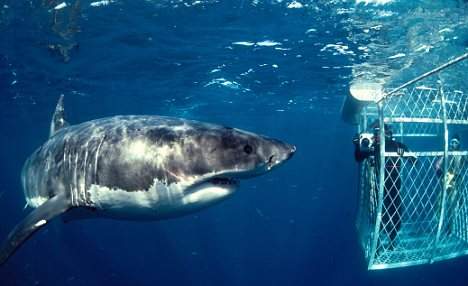
Expect to See: Great white sharks
Best Time to Go: December-June
Cage diving with sharks was actually banned in 2018 citing it was harmful to shark populations and created aggression. Luckily this was overturned a year later and cage diving is back to being a highly popular tourist attraction.
The season for cage diving with sharks in New Zealand is December through June. This is when the sharks migrate to New Zealand to feast on fur seals. During this time there is a 100% chance of seeing great whites.
The 45-60 minute ride out to the dive location does get rough so keep that in mind if you get seasick.
Some operators offer full diving experiences, air-tanks on the boat with tubes and regulators for divers, or snorkeling. Check with the dive shop to see which options are available.
Expect them to chum the waters in order to lure in the sharks. The great whites range in size from 10-20 feet (3-6 m) long.
Water temperatures vary depending on when you visit but they range from 57-74 F (14-23 C). Visibility also varies but ranges from 15-70 feet (5-21 m).
8.) Farallon Islands, San Francisco, USA
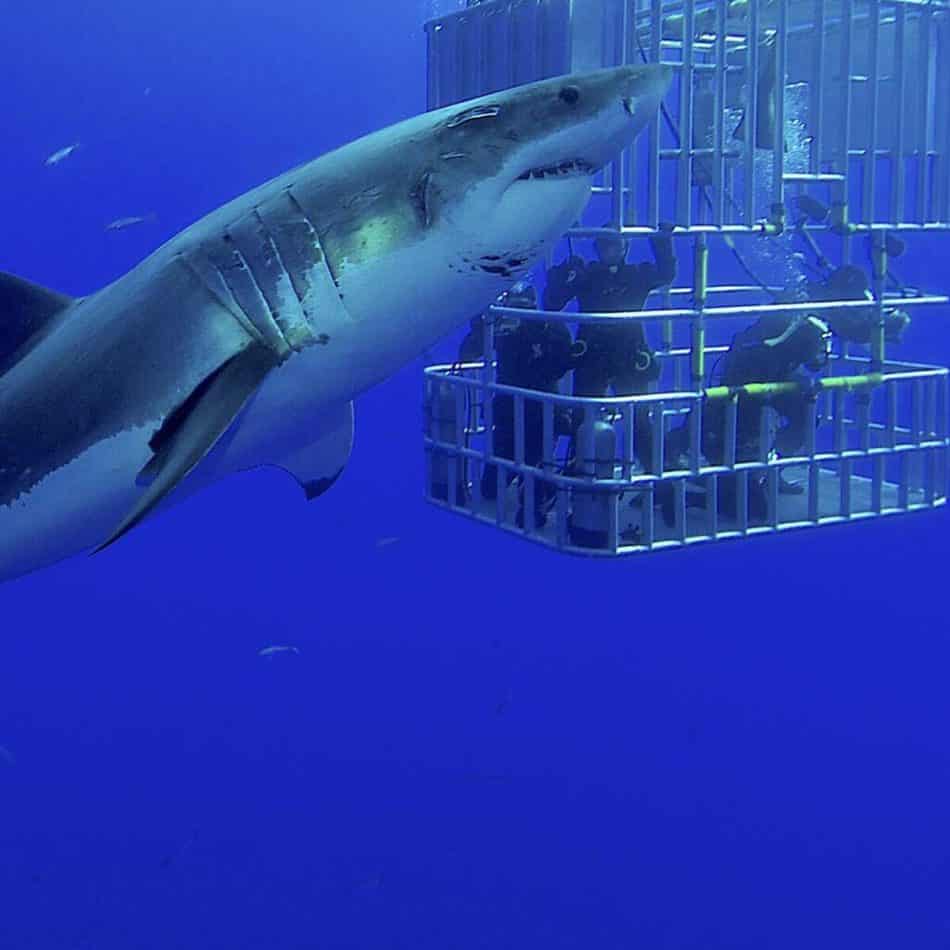
Expect to See: Great white sharks, humpback whales, blue whales, Northern elephant seals, sea lions, turtles, jellyfish
Best Time to Go: September-November
Just 30 minutes from the coast of San Fransisco, California is Farallon Island. This protected marine sanctuary is home to a dense Northern elephant seal population. Since sharks love to prey on seals, where there are seals there are sharks.
There is a large population of great whites that come here and most are 15-20 feet (4-6 m) long. Since the sharks come to feast on seals you will be actively watching nature in full effect. You will see seals get eaten.
The cages are at the surface of the water so no dive certification is actually needed to participate. Air tanks are kept on the boat and oxygen is supplied using long tubes and regulators.
The waters can get cold so wetsuits are needed along with masks. Visibility is sometimes murky and ranges from 20-50 feet (6-15 m).
Baiting is not allowed so seal decoys are used to lure the sharks near the cages.
The cage diving season runs from mid-September through the end of November. Expect cold waters of 54-57 F (12-14 C).
It’s also possible to see more than great white sharks at Farallon island. Humpback whales and blue whales migrate from Mexico and Costa Rica to eat anchovies and krill.
Also, leatherback sea turtles from Indonesia migrate here to eat jellyfish.
The boat ride out to the dive location is sometimes rough so keep that in mind if you get seasick.
7.) Cocos Island, Costa Rica
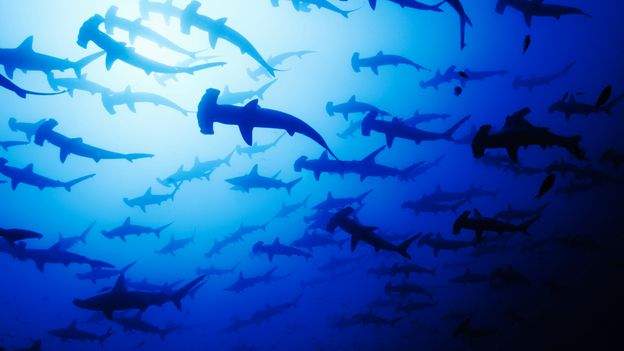
Expect to See: Hammerhead, silky, Galapagos, and tiger sharks, rays
Best Time to Go: June-October
340 miles from the shores of Coast Rica is the isolated island called Cocos. It’s a divers paradise but also a huge hub for massive groups of hammerhead sharks.
From the shores of Puntarenas, Coast Rica, it’s a 36-hour boat ride to Cocos Island. The only way to get there is on a liveaboard trip.
The island is a national park and the surrounding waters are marine protected. No one actually lives on the island and there is no accommodation or facilities otherwise.
Apart from hammerheads, you can expect to see silky, Galapagos, and tiger sharks.
Water temperatures are 79-84 F (26-29 C) and visibility is 60 -100 feet (18-30 m).
6.) Isla Mujeres, Mexico
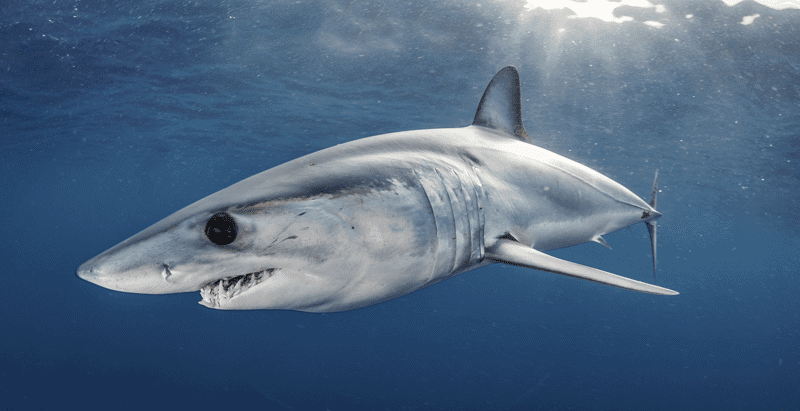
Expect to See: Mako sharks, whale sharks (June-September), bull sharks (December-February), turtles, rays, dolphins
Best Time to Go: March-April
Isla Mujeres is located near Cancun and is home to warm clear waters and lots of sharks. Mexico is a popular diving destination, especially for cage diving.
The main shark you can expect to see is the mako. They grow 6-12 feet (2-4 m) long. The mako is a dangerous shark and some say it’s more dangerous than the great white.
The mako is a dark blue color that blends perfectly into the ocean waters. They can swim up to 60 mph (96 kmh) making them professionals at sneak attacks.
The shark cages are lowered 3-4 feet (1 m) below the surface. Some operators offer a snorkel experience in the cage while others are dive experiences with air and regulators. If you have a preference, be sure to inquire with the company you book with.
Visibility is amazing at 98-164 feet (30-50 m). The water temperatures range from 72-82 F (22-28 C).
The mako season is relatively short and is the best from March-April. Organize your trip at one of the many dive operators in Cancun and most offer hotel transfers as well.
5.) Bimini Island & Tiger Beach, Bahamas

Expect to See: Bimini: Bull, tiger, and hammerhead sharks
Tiger Beach, Grand Bahamas Island: Tiger sharks
Best Time to Go: December-April
The Bahamas is a goldmine for diving. There are endless sites on just about every island. Lucky enough for shark lovers because there are two great locations for cage diving in the Bahamas.
Off Bimini Island you will see bull, tiger, and hammerhead sharks. At Tiger Beach in the Grand Bahamas Island, there are tons of tiger sharks.
Both locations offer amazing experiences and are well worth the visit. Many dive companies will take you on full-day trips to visit both cage diving sites.
The waters are warm and the visibility is fantastic. Wetsuits are optional but you will need a mask. Water temperatures range from 75-88 F (24-31 C).
Since the cages stay close to the surface there is no dive experience needed at either location. Air is supplied through regulators that are attached to air tanks on the boats. As you might expect, wetsuits and masks are required.
Best 18 Places To Scuba Dive With Sharks
Along with a healthy shark population you can also expect to see dolphins, turtles, and stingrays. There is a 100% chance of seeing sharks. No specific shark species is guaranteed but you will definitely see lots of sharks.
4.) Oahu, Hawaii, USA

Expect to See: Tiger, hammerhead, sandbar and Galapagos sharks, dolphins, turtles, humpback whales (November-May)
Best Time to Go: Year-round
Oahu Hawaii offers some amazing diving experiences. One of the most popular is cage diving with sharks. There are 40 species of sharks that populate the waters around Oahu which include hammerheads, tiger, sandbar, and Galapagos.
Tiger sharks are the most commonly seen followed by sandbar and Galapagos. Hammerheads are only spotted during certain months. The sharks range in size from 5-15 feet (1.5-4.5 m).
You will also see dolphins and turtles either at the dive site or along the journey there. Humpback whales migrate through the region from November to May.
The dive site is only 3 miles (5 km) off the northern coast of Oahu which makes for a short boat ride.
Visibility is important since you are confined to the cages. Luckily the visibility in the waters around Oahu are often 150+ feet (46+ m) and sometimes up to 200 feet (61 m).
The cages stay close to the surface of the water and there is no diving experience needed. The majority of companies offering cage dives do so without supplying oxygen. This means it’s more like snorkeling since you peek into the water and come up for air.
The water temperature ranges from 75-82 F (24-28 C).
Expect to spend about 15-20 minutes in the cage for each session. They hold up to 8 adults at a time with trained team members nearby for any assistance.
Chumming is not usually done here since there is no need for it. There are plenty of sharks without chumming.
Sharks are seen year-round so you can book a trip anytime. No matter when you go, there is a 100% guarantee of seeing sharks.
3.) Neptune Islands, Port Lincoln, Australia
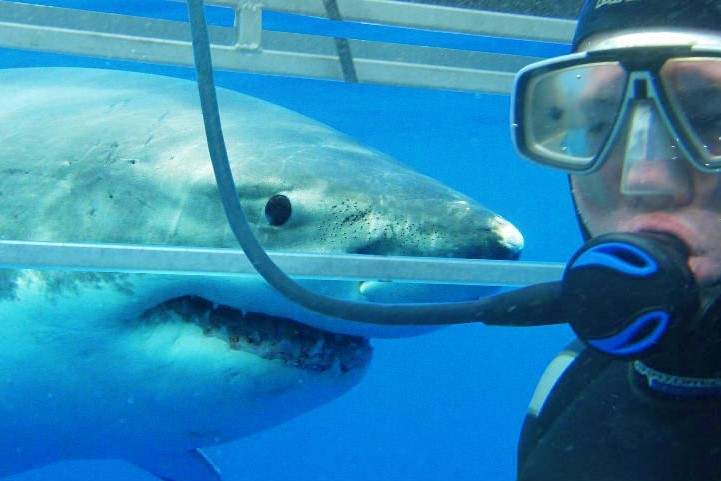
Expect to See: Great white sharks
Best Time to Go: May-October
Off the coast of Port Lincoln are two islands called the Neptune Islands. The islands are a conservation park and a protected breeding ground for New Zealand fur seals.
The Neptune Islands is a rare and special location for shark diving. It’s the only place in Australia that you can cage dive with great white sharks.
Not only that but Australia put cage diving on the map as it became one of the first places to offer it as a popular tourist attraction in the early 2000s.
Cage diving with great whites in Australia has been occurring for 30 years with no reported accidents. The cages are no more than 4 feet (1.2 m) below the surface.
No dive certification is needed. Air is kept on the boat and is supplied to participants using long tubes and regulators.
Sharks are lured in by using either bait or acoustic sounds as divers prepare and secure themselves in steel cages. The cages are then lowered into the ocean and the fun begins.
Visibility is usually 67 feet (20 m) and water temperatures range from 57-72 F (14-22 C). There is an 85% chance of seeing a great white shark during a cage dive in Australia. Most tours will allow a second trip for free if there are no sightings.
It’s a 3 hour boat trip to the Neptune Islands from Port Lincoln.
The best months to go are from May-October since this is when the great white shark frequent the area the most.
2.) Gansbaai, South Africa
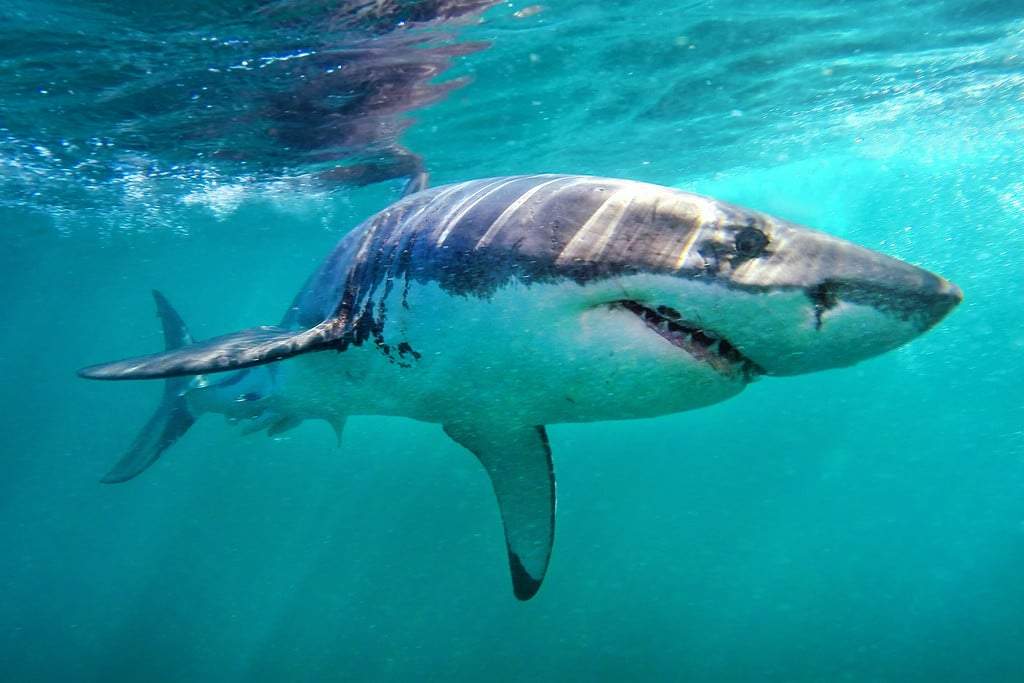
Expect to See: Great white sharks, copper sharks, dolphins, whales, seals
Best Time to Go: April-September
13 foot great whites are commonly seen feasting on nearby seals. There is a Cape Fur seal population of 60,000 which lures in the great white sharks.
This region is known to have one of the highest great white shark populations in the world. Cage diving started here 20 years ago with no signs of slowing.
It takes about 20-25 minutes to reach the site by boat. The waters are 60-7 F (15-23 C) depending on the season.
The steel cages are kept near the surface and only submerge divers as deep as 3 feet (1 m).
There are no air tanks so you only need a mask and perhaps a snorkel to go into the cage. This makes it open to anyone over the age of 10 years old. The disadvantage to this is that you constantly need to keep surfacing for air.
The waters are sometimes chummed to attract the sharks but this depends on the company you go out with. Regardless, there is a 97% chances of seeing great whites during cage dives.
Copper sharks are also often seen in the area. These bronze colored sharks grow up to 11 feet (3 m) long and prey on sardines and other boney fish.
The best months to go are from April to September when the sharks hunt seals closer to the shore. This is winter time in South Africa so the waters will be colder and the seas a bit rougher. Visibility is also better during the winter months. However, it’s still possible to shark dive year-round.
1.) Isla Guadalupe, Mexico
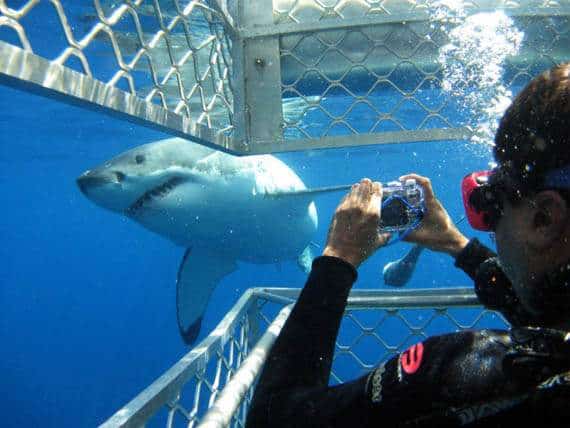
Expect to See: Great white sharks
Best Time to Go: July-November
The best cage diving in the world is in Guadalupe Island, Mexico. The waters are crystal clear and visibility peaks at 150 feet (46 m). There is no other location in the world that offers cage diving in such clear waters.
There are two different ways you can cage dive with great white sharks at Guadalupe Island. Cages can be left at the surface where you can stay at the top of the water. You don’t need to be a certified diver to experience the sharks in surface cages. Air tanks are left on the boat and fed to participants through long hoses and regulators.
Alternatively, cages can be fully submerged 30 feet (9 m) down to see where sharks naturally gather. Cages that are fully submerged are only available to certified divers.
For safety reasons, a certified divemaster accompanies all dives and there are spare air tanks in the cages.
When the cages are fully submerged and 30 feet (9 m) below the surface there is no need to chum the waters. The sharks frequent the area naturally and will circle the cage out of curiosity. This is probably when your heart will begin to race if it wasn’t already.
The best months are July-November when the sharks are most active and the water conditions are optimal. Water temperatures are 68-78 F (20-25 C) and visibility is an amazing 100-150 feet (30-46 m).
It is possible to book a 5-day liveaboard trip through Horizon Charters and depart from San Diego, USA. The ship goes directly to Guadalupe Island which bypasses immigration at the Mexico border.
